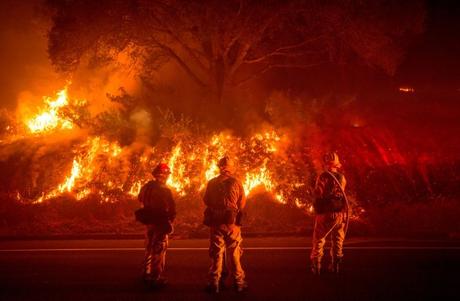 I published the blog post below in 2017. It discusses a scientific analysis and climate-change warning published in the journal Nature.
The critical element of the scientists’ conclusion was the absolutely necessity to begin immediately reducing CO2 emissions. Progress was pinned to six milestones that had to be reached by 2020. Here we are in 2020. Unfortunately, global CO2 emissions increased in 2018 and 2019 and none of the six milestones was reached. Likewise, the other disasters I mentioned are continuing to accelerate. The likelihood that human civilization will continue to progress and flourish in years to come is perhaps exactly equal to the number of times “biodiversity” or “global wildlife extinction” has been mentioned in the Democratic presidential debates: Zero. But who knows? Perhaps this year’s weather will provoke a massive mobilization similar to what it took to combat the Nazis.
I published the blog post below in 2017. It discusses a scientific analysis and climate-change warning published in the journal Nature.
The critical element of the scientists’ conclusion was the absolutely necessity to begin immediately reducing CO2 emissions. Progress was pinned to six milestones that had to be reached by 2020. Here we are in 2020. Unfortunately, global CO2 emissions increased in 2018 and 2019 and none of the six milestones was reached. Likewise, the other disasters I mentioned are continuing to accelerate. The likelihood that human civilization will continue to progress and flourish in years to come is perhaps exactly equal to the number of times “biodiversity” or “global wildlife extinction” has been mentioned in the Democratic presidential debates: Zero. But who knows? Perhaps this year’s weather will provoke a massive mobilization similar to what it took to combat the Nazis.
[Alfred E. Neuman said “What, me worry?” — perhaps he was our spokesperson after all, eh Joe?]
The 2017 Blog Post
GR [in 2017]: An article from June, 2016 should be on everyone’s mind now. Here’s my discussion followed by a link to the article.
A group of scientists analyzed the sources of CO2 and the dynamic relationship between the quantity of CO2 in the atmosphere and global temperature to devise a global carbon budget they could use to assess the effect of timing of changes in CO2 emissions. The analysis enabled them to calculate the changes we must make to preserve a livable climate. You’ll have to read the article to see the individual sources of CO2 that must be adjusted. I wanted to mention the timing for the budget. The analysis shows that if CO2 emissions begin to fall immediately and reach zero in 30 years, we will remain within the global warming limits set by the Paris treaty. After the flat emissions of 2014, 2015, and 2016, the authors believed that the fall in emissions was ready to begin. This is good, because their budget shows that if we wait to 2020 to start tapering off CO2 production, we only get 20 years to reach zero emissions. If we wait to 2025, we get less than 10 years to reach zero. Transforming our energy use that quickly would be impossible.
SO, how are we doing. Six months after the analysis was published, we find that 2017 emissions have gone up, not down. Lot’s of positive changes have begun, but we have to wait to see what happens in 2018. If we begin to taper off CO2 emissions by 2020, we will have 20 years to reach zero emissions. I suggest you take a look at the six milestones the authors believe must be reached by 2020. Then you can monitor the world’s progress toward painful climate change (the Paris treaty) or disastrous climate change (with too many storms, fires, heat waves, and rising seas).
Climate change is just one of the approaching disasters. Human population and its impact is growing, wildlife species are going extinct at incredible rates, freshwater supplies are dropping, and toxic wastes are building up. If we can’t do much more than take our CO2 emissions to zero over the next 20 years, most of the diversity and beauty of life on Earth will disappear.


